Every Building Tells a Story: Brook and North Brook Streets
John Marks, Curator of Collections and Exhibits
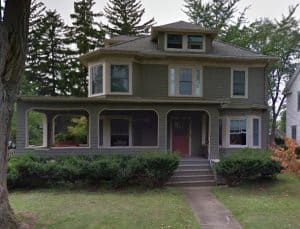
156 North Brook Street
There is no quick way from the north side of Geneva to Hamilton Street. If you’re on North Street near the hospital you’re consigned to driving down Main Street to Hamilton and then heading west – and if you’re grocery shopping in Geneva, you always end up on Hamilton Street. The other route is to North Brook Street to High Street, west to Nursery Avenue, and thence over to Hamilton Street.

22 North Brook Street
Brook Street has greater meaning than just a pass-through for shopping errands. It’s in the heart of the Hildreth Hill neighborhood that each year sponsors a pumpkin roll down the Brook Street hill. The Brook Street Playground and Len DeFrancesco Tennis Courts are a hub of neighborhood and city-wide activity. North Brook Street has the only traffic circle in Geneva and it is a gathering spot in the Castle Heights neighborhood.
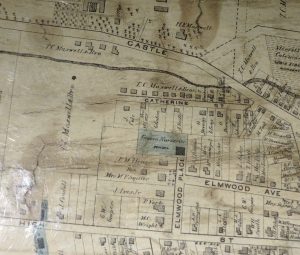
Although a continuous street, Brook Street has two designations. Brook Street runs from High Street to Castle Street while North Brook begins at Castle and goes to North Street. Neither one existed in 1870 (to the left) when the land was owned by the T.C. Maxwell & Bro. nursery company. When in doubt, we can assume that most of the land west and north of downtown was owned by nurseries in the 19th century.
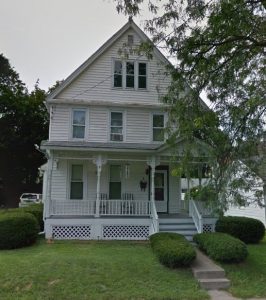
72 Brook Street was listed in the 1894 directory as the home of Hobart Gray, an optical worker.
Brook Street’s first appearance in the village directories was 1894. There were five houses between High and Castle Streets. The owners seemed to be skilled working class: two masons, a street commissioner, a clerk, and an optical worker. In 1893 the Geneva Optical Company (later Standard Optical) moved from Linden Street to a new factory on Lyceum Street. More employees purchased homes on Brook Street to be a few blocks away from their workplace.
Brook Street developed fairly slowly over the next 16 years. Like other Geneva streets, houses were built in seemingly random order rather than sequentially from one end of the street. By 1910 it was well-developed and residents included plumbers, carpenters, teamsters, and insurance agents.
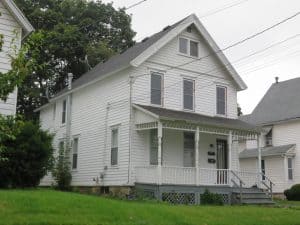
In the 1910 directory, 9 Brook Street (adjacent to the playground) first appeared as the home of Frank Schwab, a Standard Optical Company machinist.
Twentieth-century Geneva city directories included a city map attached at the back. Few survive as they were printed on very thin paper but, when found, they are very interesting. The 1910 directory map shows North Brook on the map but no houses appear in the book until 1915. The first houses were built near but not at the corner of North Street.
Brook Street houses were primarily built with the narrow gable end facing the street. The width of the house, represented by the number of window or door openings, and the porch treatment were the main differences among similar houses. Built 20 or 30 years later, North Brook Street homes reflected a wider variety of style choices.
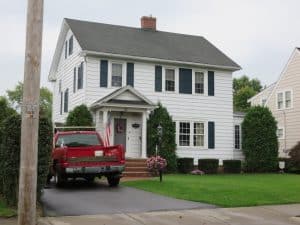
21 North Brook Street
The early North Brook homeowners were solidly middle class and employed at some of the same companies as their Brook Street neighbors but in higher positions. James Brown (21) was a treasurer for Geneva Optical Company while J. Murray Means (156) held the same job for White Springs Dairy. James Brew (22) was a bacteriologist at the Agricultural Experiment Station.
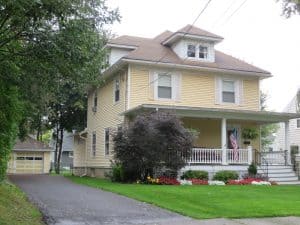
The 1925 owner of 98 North Brook Street, Mason Badgley, was a foreman at American Can.
We view modern neighborhoods through several factors: current real estate prices, conditions of surrounding properties, and personal knowledge or perceptions. It can be a fun exercise to look at neighborhoods in their original context and learn more about how new streets and houses were marketed to buyers. Our archives has a number of resources if you’re interested in learning more about your home.

excellent I really enjoyed reading it and wish I could visit this neighborhood but I live in Utah . My Irish ancestors settled in Geneva after immigrating to the USA during the famine years !846 to 1849. They were married 1852 at St. Stephen’s Church and lived, I think, on Jackson Street. I would love to know why the Irish immigrants settled in Geneva and wish someone who writes as well as this blogger would cover that some day. March of 2018 will be here soon—St. Patrick’s is March 17th.
Very informative and enjoyable reading. Really brings the streets to life. Hope you can do more such articles. My great grandfather Edson Updike, a grocer at the SEcorner of Main and Castle, bought the land to build 198 Lewis Street from Joshua Maxwell in 1888.
It would be interesting to know why the circle was constructed at the intersection of Lafayette and North Brook St. Our family lived at 124 North Brook st for about 45 years. If one looks nothing at the circle from our house you can see that the east side of North Brook St. lines up with the west side of North Brook St on the other side of the circle. I thought that there may have been a surveying error when the construction of the north part of the street was constructed and they only way to correct it was with creating a circle. Go check it out. I often stood in the street and ponder this.